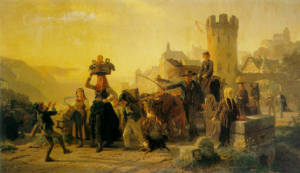Today, a reprint of last year’s chapter for the Nativity of Mary. I know of some folks in Switzerland who will be “driving down” their livestock today, down to the valleys, and the animals will be wearing bells and flowers. As for Seth & me, the coffee is on, and there are Canadian blueberries for breakfast.
Now we are well into September and in places where there are vineyards, the grapes are ripening on the vines, speaking of great alchemical potential: crushed and barreled and left to ferment, activating natural yeasts and sugars, the next wines are about to be made.
The timing of today’s feast––at the start of the grape harvest––is, to me at least, interesting. Nine months ago we celebrated the solemnity of the Immaculate Conception, and today, we celebrate the Nativity of Mary. The Church celebrates the deaths of saints (don’t you love when I tell you all those gruesome tales of how saints met their ends?) but in the case of Mary and John the Baptist, also their births. And tradition tells us that Mary was born on this day in Jerusalem to St. Ann and St. Joachim.
Italians like to eat blueberries for this day, a day important to all Marias and Mariettas… and there are many in my family. The blue of the berry is a reference to the traditional color of Mary’s cloak. Lights are illuminated in windows, especially in the rural areas, and bonfires are not uncommon on this night. Across the Alps, in Austria, it is time to bring the sheep and cattle down from the mountains and into the valleys: winter is fast approaching, and the Nativity of Mary on the 8th of September is known there as “Drive Down Day” in honor of this custom of moving the animals, often with some pomp and ceremony.
In France, though, there is this nice connection between the Nativity of Mary and wine: winemakers refer to the day as “Our Lady of the Grape Harvest,” bringing their best grapes to church for blessing. Across France you will find bunches of grapes placed in the hands of statues of Mary on this day. I like this connection between Mary, a goddess of sorts, and wine, especially as we ponder the bread and wine that is central to each church Mass, but central also to any good meal in places throughout Europe. These two elements can easily be a meal unto themselves (“a jug of wine, a loaf of bread, and thou”), should that be all you have, and you’d walk away sated and probably quite happy.
Image: Setting Out for the Grape Harvest by Christian Eduard Böttcher. Oil on canvas, 1867, [Public domain] via Wikimedia Commons.

Since this is not my heritage, I find the story fascinating. Its interesting to learn of the connection of Mary to blueberries, grapes and wine. I am going to ask my Italian friends about this and share it with my “winey” friends. I always learn something from your blog. If I ever decide to go on Jeopardy, I’m going to call on you to prep for the show; I thought I had a lot of knowledge, this is a whole new vocabulary.
Thanks for sharing!
I’m not sure what Jeopardy category I’d help you with, but we can prep over wine, how’s that?
Where do you get Canadian blueberries? I find blueberries so unappetizing as they have lost all of their flavor. Canadian, though–sounds like they might be delicious like the little ones I used to get in northern New Hampshire…
Are you local, Jody? The blueberries I’m buying now at the Lake Worth Publix are from Canada. I watch the blueberry carton labels as the weeks progress through spring and summer with my usual nerdy seasonal fascination. The first blueberries begin here in Florida, then they next come from the Carolinas, then New Jersey… and now, these last blueberries of the season, from Canada. They do seem smaller than the typical grocery store blueberry… but they are still not the wild Maine blueberries that Seth and I love so much.